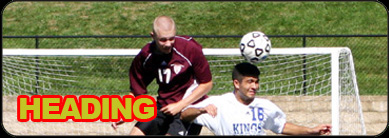 This is the ability to redirect a ball that is in the air using your head. It could be defensive or attacking. If you head the ball incorrectly you will remember, because it will hurt. However, you should not be scared to head the ball correctly, because using the correct technique heading the ball does not hurt. It is a great skill to learn, it enables you to get to the ball before other players that will wait for it to drop to the floor. Getting to the ball first is an important part of the game.
This is the ability to redirect a ball that is in the air using your head. It could be defensive or attacking. If you head the ball incorrectly you will remember, because it will hurt. However, you should not be scared to head the ball correctly, because using the correct technique heading the ball does not hurt. It is a great skill to learn, it enables you to get to the ball before other players that will wait for it to drop to the floor. Getting to the ball first is an important part of the game.
The first thing that any coach will tell you when learning to head the ball is to keep your eye on the ball and not to close your eyes.
There is only one part of the head that you want to make contact with the ball, the forehead, the hard part at the front of your head.
Watch the ball as it comes towards you, move your head back a bit so that you can bring it forward and hit the ball with your head. Don’t let the ball hit you, you hit it!
Have a look at these two below!
To make the ball go up we head the bottom half of the ball (below it’s equator).
To make the ball go/stay down, we head the ball on the top half of the ball (the same as when we kick the ball.)
When we head the ball down, this is usually considered an attacking header, as when the ball is low we can kick the ball in the goal.
If we head the ball up into the air, we generally call this a defensive header. As when the ball is in the air, no one can kick it in the goal.
To get power into your header, you can lean back and bring more of your whole body weight forward as you make contact with the ball. You can also do this by running and jumping to meet the ball.
Probably the best way to start learning is by throwing the ball in the air, heading it back up into the air and catching it.
Once you have mastered this you can try throwing the ball in the air, heading it, heading it again and then catching it and so on.
The video below is a good demonstration of this.
Here you can watch Sol Campbell in training, making one run backwards before running forwards. This is to take his defender away from the area that he wants to attack. By moving backwards and then running forwards he assures he can beat his defender to the ball and he can head it with power. It also helps him to judge getting himself into the line of the flight of the ball, so he can meet it head on.
When he jumps he swings his arms up to help lift himself from the ground, this also helps to protect him from anyone else that might be trying to head the same ball.
(play John Terry’s game for some fun)
There are other types of header as well. The diving header is a spectacular header that requires you to jump outstretched, with your arms in front of you to protect yourself when landing.
Alan Shearer puts in a dramatic diving header
Zach Forbes scores a great diving header
Henrik Larson’s diving header for Sweden
The glancing header is when you turn your head to one side or the other to redirect the ball in that direction.
The flick header requires you to flick your head backwards, sometimes connecting the back of your head with the ball, moving the ball on in the space behind you.
See if you can identify the different types of headers in the video below, a collection of headers from Christiano Ronaldo:





